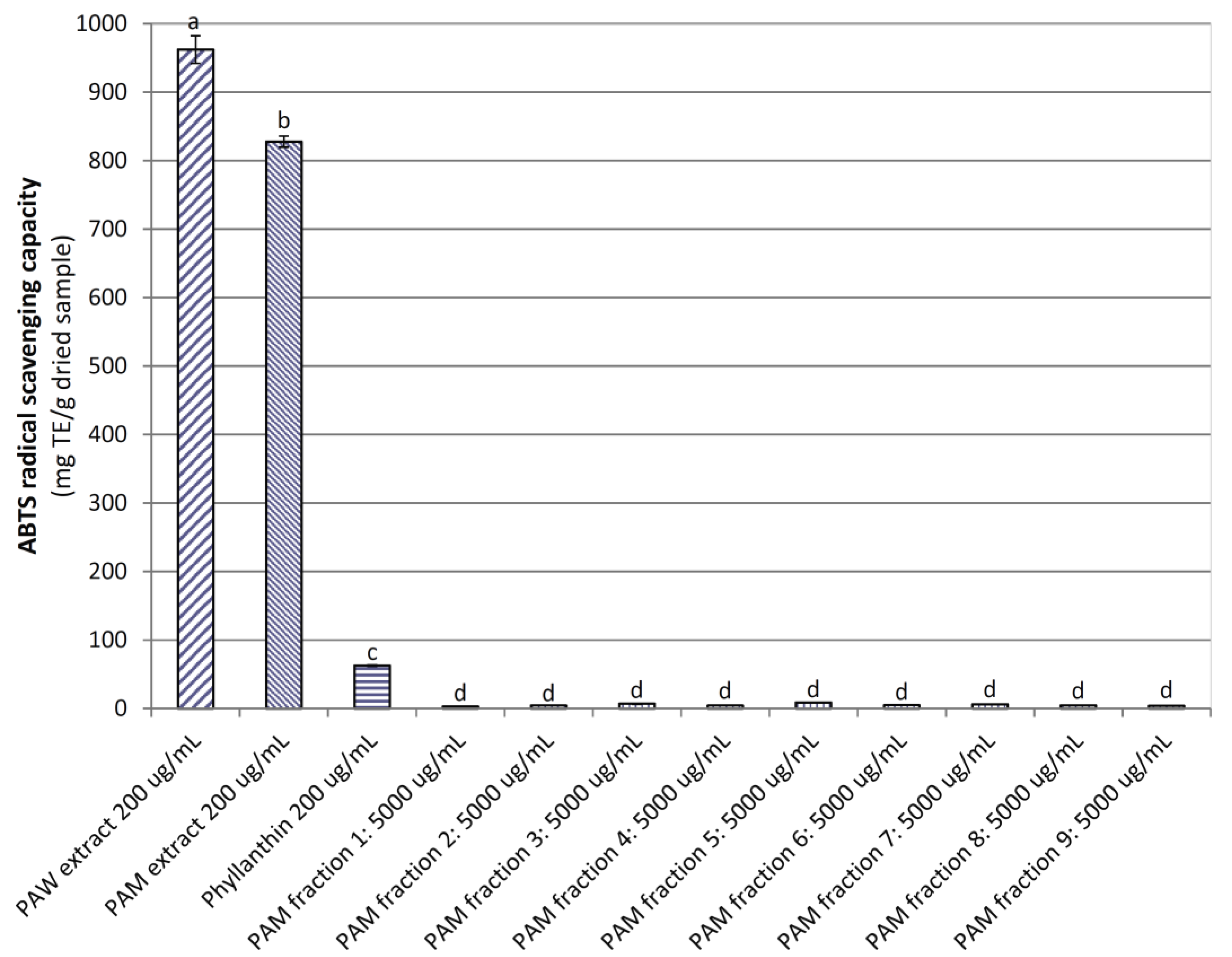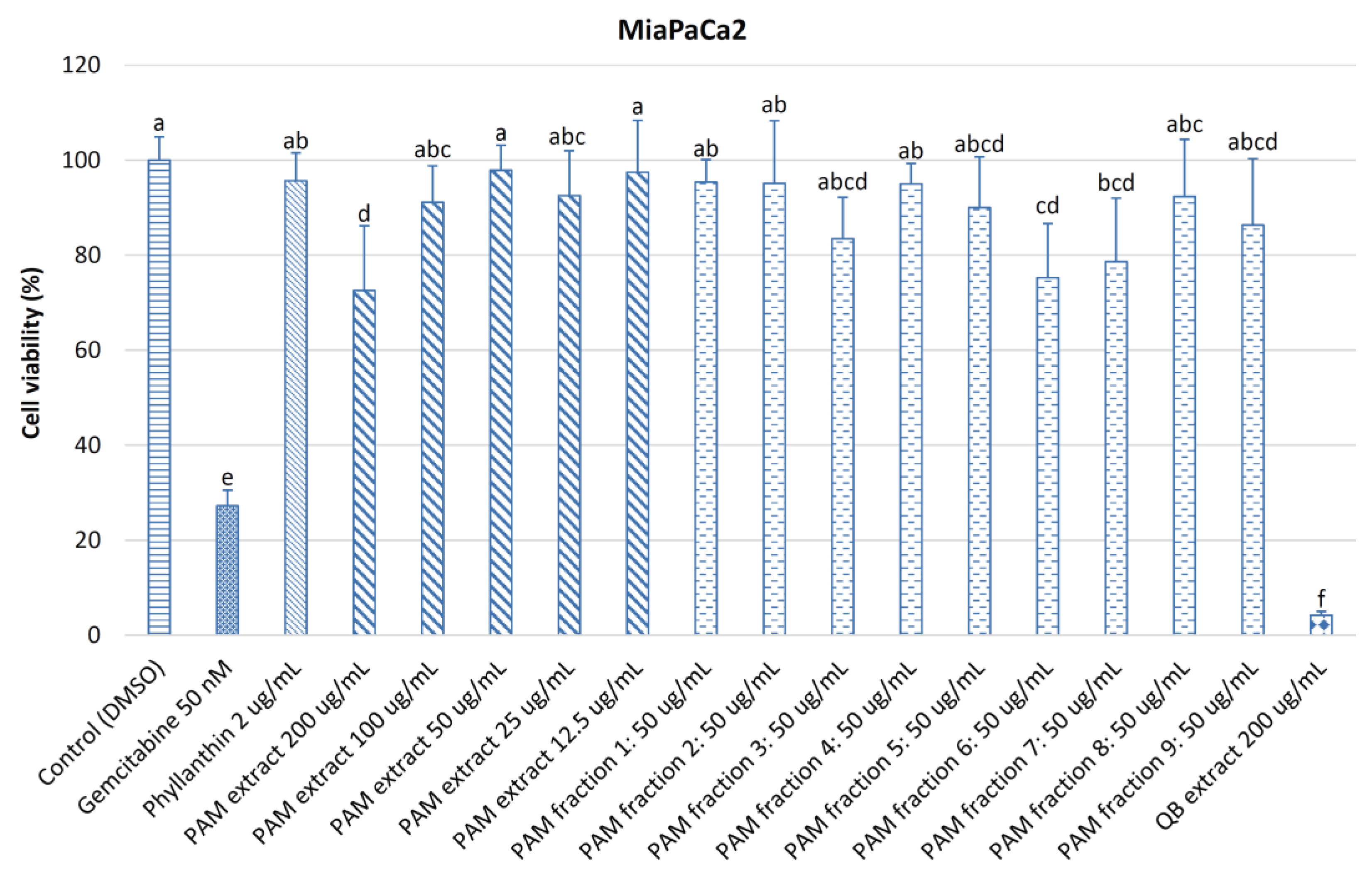Physicochemical Properties, Antioxidant and Cytotoxic Activities of Crude Extracts and Fractions from Phyllanthus amarus
Abstract
:1. Introduction
2. Materials and Methods
2.1. Plant Material
2.2. Analytical Chemicals
2.3. Preparation of Powdered P. amarus Extracts
2.4. Determination of Physicochemical Properties of Powdered P. amarus Extracts
2.4.1. Residual Moisture and Water Activity
2.4.2. Total Phenolic Content (TPC)
2.4.3. Total Flavonoid Content (TFC)
2.4.4. Proanthocyanidin Content
2.4.5. Saponin Content (SC)
2.4.6. Isolation of Major Fractions from P. amarus Methanol (PAM) Extract
2.5. Determination of Antioxidant Capacity of Powdered P. amarus Extracts and Fractions
2.5.1. ABTS Radical Scavenging Capacity (ARSC)
2.5.2. DPPH Radical Scavenging Capacity (DRSC)
2.5.3. Ferric Reducing Antioxidant Power (FRAP)
2.6. Assessment of Cytotoxic Potential of Powdered P. amarus Extracts and Fractions
2.6.1. Growth Inhibition of Cancer Cell Lines by PA Extracts
2.6.2. Viability of Pancreatic Cancer and Normal Cells by Treatment with P. amarus Methanol (PAM) Extract and Fractions
Cell Culture
Cell Viability
2.7. Statistical Analysis
3. Results and Discussion
3.1. Physicochemical Properties of Powdered P. amarus Extracts
3.2. Major Fractions Isolated from P. amarus Methanol (PAM) Extract
3.3. Antioxidant Capacity of Powdered P. amarus Extracts and Fractions
3.4. Cytotoxic Potential of Powdered P. amarus Extracts and Fractions
3.4.1. Growth Inhibition of Cancer Cell Lines by PA Extracts
3.4.2. Viability of Pancreatic Cancer and Normal Cells by treatment with P. amarus Methanol (PAM) Extract and Its Fractions
4. Conclusions
Acknowledgments
Author Contributions
Conflicts of Interest
References
- Li, L.; Leung, P.S. Use of herbal medicines and natural products: An alternative approach to overcoming the apoptotic resistance of pancreatic cancer. Int. J. Biochem. Cell Biol. 2014, 53, 224–236. [Google Scholar] [CrossRef] [PubMed]
- Jamieson, N.B.; Grimmond, S.M.; Biankin, A.V.; Chang, D.K.; Initiative, A.P.C.G. Pancreatic cancer: challenges for therapeutic development. In Plant Bioactive Compounds for Pancreatic Cancer Prevention and Treatment; Scarlett, C.J., Vuong, Q.V., Eds.; Nova Science Publishers: Hauppauge, NY, USA, 2014; pp. 1–27. [Google Scholar]
- Ji, X.; Usman, A.; Razalli, N.H.; Sambanthamurthi, R.; Gupta, S.V. Oil palm phenolics (OPP) inhibit pancreatic cancer cell proliferation via suppression of NF-κB pathway. Anticancer Res. 2015, 31, 97–106. [Google Scholar]
- Nguyen, V.T.; Sakoff, J.A.; Scarlett, C.J. Physicochemical, antioxidant and cytotoxic properties of Xao tam phan (Paramignya trimera) root extract and its fractions. Chem. Biodivers. 2017, 14. [Google Scholar] [CrossRef] [PubMed]
- Pozza, E.D.; Donadelli, M.; Costanzo, C.; Zaniboni, T.; Dando, I.; Franchini, M.; Arpicco, S.; Scarpa, A.; Palmieri, M. Gemcitabine response in pancreatic adenocarcinoma cells is synergistically enhanced by dithiocarbamate derivatives. Free Rad. Biol. Med. 2011, 50, 926–933. [Google Scholar] [CrossRef] [PubMed]
- Graham, J.S.; Jamieson, N.B.; Rulach, R.; Grimmond, S.M.; Chang, D.K.; Biankin, A.V. Pancreatic cancer genomics: where can the science take us? Clin. Gen. 2015. [Google Scholar] [CrossRef] [PubMed]
- Nguyen, V.T.; Sakoff, J.A.; Scarlett, C.J. Physicochemical properties, antioxidant and anti-proliferative capacities of dried leaf and its extract from Xao tam phan (Paramignya trimera). Chem. Biodivers. 2017. [Google Scholar] [CrossRef] [PubMed]
- Newman, D.J.; Cragg, G.M. Natural products as sources of new drugs over the last 25 years. J. Nat. Prod. 2007, 70, 461–477. [Google Scholar] [CrossRef] [PubMed]
- Colvin, E.K. History and development of plant-derived anti-cancer agents. In Plant Bioactive Compounds for Pancreatic Cancer Prevention and Treatment; Scarlett, C.J., Vuong, Q.V., Eds.; Nova Science Publishers: Hauppauge, NY, USA, 2014; pp. 29–43. [Google Scholar]
- Pengelly, A. Traditional use of plants as folk medicine. In Plant Bioactive Compounds for Pancreatic Cancer Prevention and Treatment; Scarlett, C.J., Vuong, Q.V., Eds.; Nova Science Publishers: Hauppauge, NY, USA, 2014; pp. 46–58. [Google Scholar]
- Igwe, C.U.; Nwaogu, L.A.; Ujuwondu, C.O. Assessment of the hepatic effects, phytochemical and proximate compositions of Phyllanthus amarus. Afr. J. Biotechnol. 2007, 6, 728–731. [Google Scholar]
- Patel, J.R.; Tripathib, P.; Sharmaa, V.; Chauhana, N.S.; Dixit, V.K. Phyllanthus amarus: Ethnomedicinal uses, phytochemistry and pharmacology: A review. J. Ethnopharmarcol. 2011, 138, 286–313. [Google Scholar] [CrossRef] [PubMed]
- Nikam, P.S.; Nikam, S.V.; Sontakke, A.V. Lipid peroxidation and antioxidants during treatment of hepatitis -b with Phyllanthus amarus. Int. J. Biol. Med. Res. 2010, 1, 41–43. [Google Scholar]
- Nikam, P.S.; Nikam, S.V.; Sontakke, A.V.; Khanwelkar, C.C. Role of Phyllanthus amarus treatment in Hepatitis-C. Biomed. Res. 2011, 22, 319–322. [Google Scholar]
- Nguyen, V.T.; Vuong, Q.V.; Bowyer, M.C.; van Altena, I.A.; Scarlett, C.J. Effects of different drying methods on bioactive compound yield and antioxidant capacity of Phyllanthus amarus. Dry. Technol. J. 2015, 33, 1006–1017. [Google Scholar] [CrossRef]
- Nguyen, V.T.; Pham, H.N.T.; Bowyer, M.C.; van Altena, I.A.; Scarlett, C.J. Influence of solvents and novel extraction methods on bioactive compounds and antioxidant capacity of Phyllanthus amarus. Chem. Pap. 2016, 70, 556–566. [Google Scholar] [CrossRef]
- Nguyen, V.T.; Bowyer, M.C.; van Altena, I.A.; Scarlett, C.J. Optimisation of microwave-assisted extraction from Phyllanthus amarus for phenolic compounds-enriched extracts and antioxidant capacity. Chem. Pap. 2016, 70, 713–725. [Google Scholar] [CrossRef]
- Lawson-Evi, P.; Eklu-Gadegbeku, K.; Agbonon, A.; Aklikokou, K.; Moukha, S.; Creppy, E.E.; Gbéassor, M. Toxicological assessment on extracts of Phyllanthus amarus Schum and thonn. Sci. Res. Essays 2008, 3, 410–415. [Google Scholar]
- Lee, S.H.; Jaganath, I.B.; Wang, S.M.; Sekaran, S.D. Antimetastatic effects of Phyllanthus on human lung (A549) and breast (MCF-7) cancer cell lines. PLoS ONE 2011, 6, e20994. [Google Scholar] [CrossRef] [PubMed]
- Abhyankar, G.; Suprasanna, P.; Pandey, B.N.; Mishra, K.P.; Rao, K.V.; Reddy, V.D. Hairy root extract of Phyllanthus amarus induces apoptotic cell death in human breast cancer cells. Innov. Food Sci. Emerg. Technol. 2010, 11, 526–532. [Google Scholar] [CrossRef]
- Poompachee, K.; Chudapongse, N. Comparison of the antioxidant and cytotoxic activities of Phyllanthus virgatus and Phyllanthus amarus extracts. Med. Principl. Prac. 2011, 21, 24–29. [Google Scholar] [CrossRef] [PubMed]
- Association of Official Analytical Chemists (AOAC). Official Methods of Analysis, 16th ed.; Association of Official Analytical Chemists: Washington, DC, USA, 1998. [Google Scholar]
- Nguyen, V.T.; Vuong, Q.V.; Bowyer, M.C.; van Altena, I.A.; Scarlett, C.J. Microwave-assisted extraction for saponins and antioxidant capacity from Xao tam phan (Paramignya trimera) root. J. Food Process. Preserv. Early View 2016. [Google Scholar] [CrossRef]
- Vuong, Q.V.; Hirun, S.; Roach, P.D.; Bowyer, M.C.; Phillips, P.A.; Scarlett, C.J. Effect of extraction conditions on total phenolic compounds and antioxidant activities of Carica papaya leaf aqueous extracts. J. Herb. Med. 2013, 3, 104–111. [Google Scholar] [CrossRef]
- Nguyen, V.T.; Pham, N.M.Q.; Vuong, Q.V.; Bowyer, M.C.; van Altena, I.A.; Scarlett, C.J. Phytochemical retention and antioxidant capacity of Xao tam phan (Paramignya trimera) root as prepared by different drying methods. Dry. Technol. J. 2016, 34, 324–334. [Google Scholar] [CrossRef]
- Kamonwannasit, S.; Nantapong, N.; Kumkrai, P.; Luecha, P.; Kupittayanant, S.; Chudapongse, N. Antibacterial activity of Aquilaria crassna leaf extract against Staphylococcus epidermidis by disruption of cell wall. Ann. Clin. Microbiol. Antimicro. 2013, 12, 1–7. [Google Scholar] [CrossRef] [PubMed]
- Pisoschi, A.M.; Negulescu, G.P. Methods for total antioxidant activity determination: a review. Biochem. Anal. Biochem. 2011, 1, 1–10. [Google Scholar] [CrossRef]
- Vuong, Q.V.; Hirun, S.; Chuen, T.L.K.; Goldsmith, C.D.; Munro, B.; Bowyer, M.C.; Chalmers, A.C.; Sakoff, J.A.; Phillips, P.A.; Scarlett, C.J.; et al. Physicochemical, antioxidant and anti-cancer activity of a Eucalyptus robusta (Sm.) leaf aqueous extract. Ind. Crops Prod. 2015, 64, 167–174. [Google Scholar] [CrossRef]
- Tan, S.P.; Vuong, Q.V.; Stathopoulos, C.E.; Parks, S.E.; Roach, P.D. Optimized aqueous extraction of saponins from bitter melon for production of a saponin-enriched bitter melon powder. J. Food Sci. 2014, 79, E1372–E1381. [Google Scholar] [CrossRef] [PubMed]
- Chirife, J.; Fontana, A.J. Introduction: Historical highlights of water activity research. In Water Activity in Foods: Fundamentals and Applications; Barbosa-Cánovas, G.V., Fontana, A.J., Schmidt, S.J., Labuza, T.P., Eds.; Blackwell Publishing: Iowa, IA, USA, 2008; pp. 3–13. [Google Scholar]
- Pham, H.N.T.; Nguyen, V.T.; Vuong, Q.V.; Bowyer, M.C.; Scarlett, C.J. Bioactive compound yield and antioxidant capacity of Helicteres hirsuta Lour. stem as affected by various solvents and drying methods. J. Food Process. Preserv. 2016, 41, 1–9. [Google Scholar] [CrossRef]
- Man, S.; Gao, W.; Zhang, Y.; Huang, L.; Liu, C. Chemical study and medical application of saponins as anti-cancer agents. Fitoterapia 2010, 81, 703–714. [Google Scholar] [CrossRef] [PubMed]
- Vuong, Q.V.; Hirun, S.; Chuen, T.L.K.; Goldsmith, C.D.; Murchie, S.; Bowyer, M.C.; Phillips, P.A.; Scarlett, C.J. Antioxidant and anticancer capacity of saponin-enriched Carica papaya leaf extracts. Int. J. Food Sci. Technol. 2015, 50, 169–177. [Google Scholar] [CrossRef]
- Doughari, J.H. Phytochemicals-a global perspective of their role in nutrition and health. In Phytochemicals: Extraction Methods, Basic Structures and Mode of Action as Potential Chemotherapeutic Agents; Rao, V., Ed.; InTech Europe: Rijeka, Croatia, 2012; pp. 1–32. [Google Scholar]
- Nguyen, V.T.; Bowyer, M.C.; Vuong, Q.V.; van Altena, I.A.; Scarlett, C.J. Phytochemicals and antioxidant capacity of Xao tam phan (Paramignya trimera) root as affected by various solvents and extraction methods. Ind. Crops Prod. 2015, 67, 192–200. [Google Scholar] [CrossRef]
- Krithika, R.; Mohankumar, R.; Verma, R.J.; Shrivastav, P.S.; Mohamad, I.L.; Gunasekaran, P.; Narasimhan, S. Isolation, characterization and antioxidative effect of phyllanthin against CCl4-induced toxicity in HepG2 cell line. Chem.-Biol. Interact. 2009, 181, 351–358. [Google Scholar] [CrossRef] [PubMed]
- Munro, B.; Vuong, Q.V.; Chalmers, A.C.; Goldsmith, C.D.; Bowyer, M.C.; Scarlett, C.J. Phytochemical, antioxidant and anti-cancer properties of Euphorbia tirucalli methanolic and aqueous extracts. Antioxidants 2015, 4, 647–661. [Google Scholar] [CrossRef] [PubMed]
- Vuong, Q.V.; Sadeqzadeh, E.; Hirun, S.; Goldsmith, C.D.; Zammitt, N.; Bowyer, M.C.; Sakoff, J.A.; Thorne, R.F.; Weidenhofer, J.; Scarlett, C.J.; et al. Phenolic compounds, antioxidant and anti-cancer properties of the Australian maroon bush scaevola spinescens (Goodeniaceae). J. Bioanal. Biomed. 2015, S12. [Google Scholar] [CrossRef]
- Vuong, Q.V.; Hiruna, S.; Chuen, T.L.K.; Goldsmith, C.D.; Bowyer, M.C.; Chalmers, A.C.; Phillips, P.A.; Scarlett, C.J. Physicochemical composition, antioxidant and anti-proliferative capacity of a lilly pilly (Syzygium paniculatum) extract. J. Herb. Med. 2014, 4, 134–140. [Google Scholar] [CrossRef]






| Properties | Water Extract | Methanol Extract |
|---|---|---|
| Residual moisture (%) | 8.85 ± 0.74 * | 7.40 ± 0.14 |
| Water activity (aw) | 0.35 ± 0.02 | 0.24 ± 0.02 |
| Total phenolic content (mg GAE/g dried extract) | 86.89 ± 6.06 | 250.45 ± 11.93 |
| Total flavonoid content (mg RE/g dried extract) | 158.17 ± 14.38 | 274.73 ± 1.56 |
| Proanthocyanidin content (mg CE/g dried extract) | 37.05 ± 6.03 | 61.22 ± 13.94 |
| Saponin content (mg EE/g dried extract) | 1037.34 ± 52.17 | 1657.86 ± 441.62 |
| Cancer Cell Line (Cell Type) | % Cell Growth Inhibition at 100 μg/mL of PA Extracts (n = 3–6) | |
|---|---|---|
| Water (PAW) Extract | Methanol (PAM) Extract | |
| MiaPaCa2 (pancreas) | 38 ± 5 | 48 ± 3 |
| HT29 (colon) | 23 ± 3 | 49 ± 7 |
| A2780 (ovarian) | 46 ± 4 | 74 ± 3 |
| H460 (lung) | 16 ± 5 | 53 ± 3 |
| A431 (skin) | 31 ± 1 | 74 ± 2 |
| Du145 (prostate) | 26 ± 8 | 73 ± 3 |
| BE2-C (neuroblastoma) | 51 ± 14 | 54 ± 4 |
| MCF-7 (breast) | 16 ± 4 | 67 ± 8 |
| MCF-10A (breast-normal) | 43 ± 7 | 73 ± 2 |
| U87 (glioblastoma) | 23 ± 6 | 62 ± 10 |
| SJ-G2 (glioblastoma) | 28 ± 1 | 54 ± 10 |
| SMA (glioblastoma-murine) | 49 ± 18 | 31 ± 13 |
© 2017 by the authors. Licensee MDPI, Basel, Switzerland. This article is an open access article distributed under the terms and conditions of the Creative Commons Attribution (CC BY) license (http://creativecommons.org/licenses/by/4.0/).
Share and Cite
Nguyen, V.T.; Sakoff, J.A.; Scarlett, C.J. Physicochemical Properties, Antioxidant and Cytotoxic Activities of Crude Extracts and Fractions from Phyllanthus amarus. Medicines 2017, 4, 42. https://doi.org/10.3390/medicines4020042
Nguyen VT, Sakoff JA, Scarlett CJ. Physicochemical Properties, Antioxidant and Cytotoxic Activities of Crude Extracts and Fractions from Phyllanthus amarus. Medicines. 2017; 4(2):42. https://doi.org/10.3390/medicines4020042
Chicago/Turabian StyleNguyen, Van Tang, Jennette A. Sakoff, and Christopher J. Scarlett. 2017. "Physicochemical Properties, Antioxidant and Cytotoxic Activities of Crude Extracts and Fractions from Phyllanthus amarus" Medicines 4, no. 2: 42. https://doi.org/10.3390/medicines4020042






